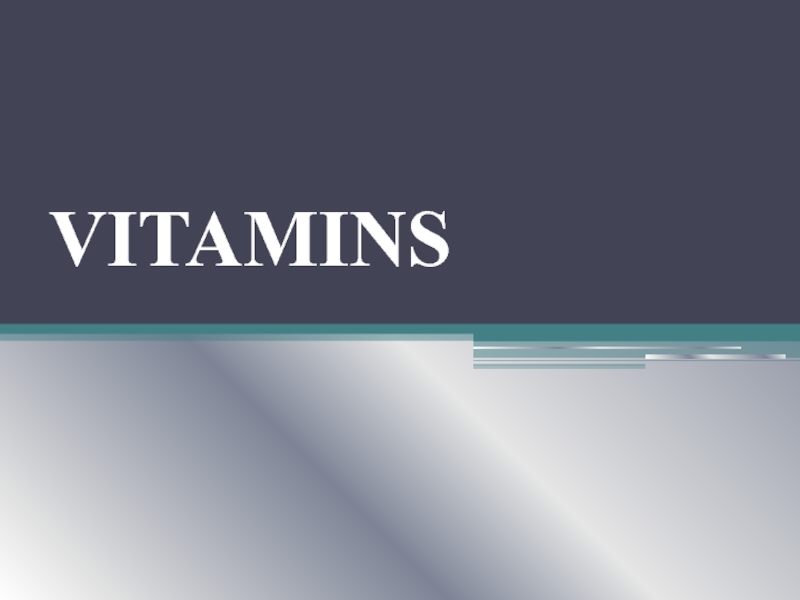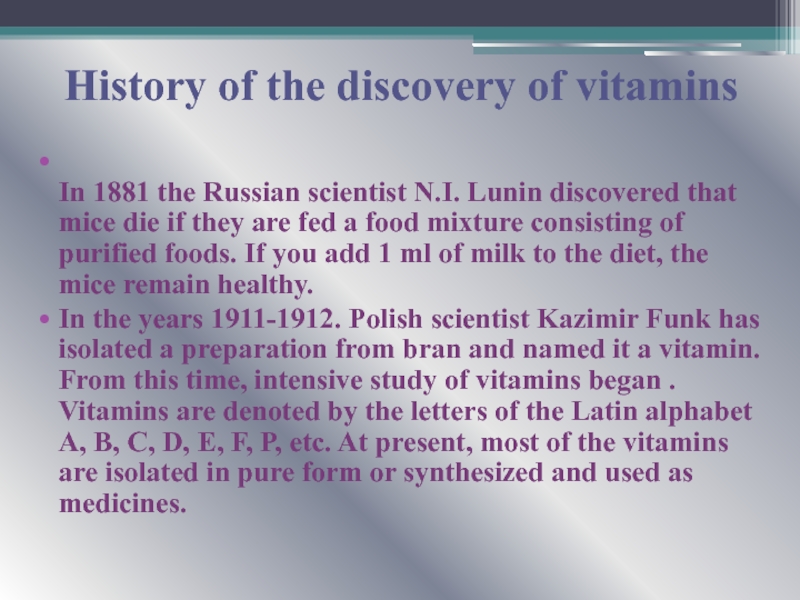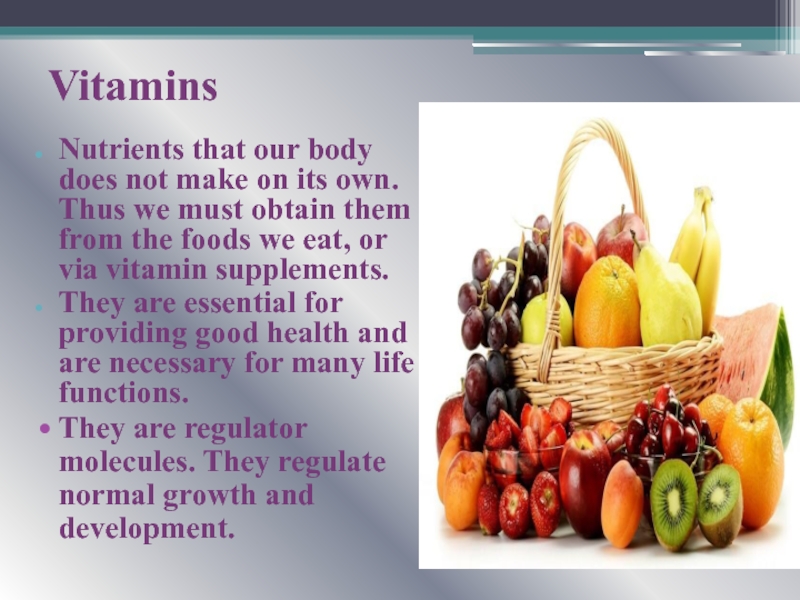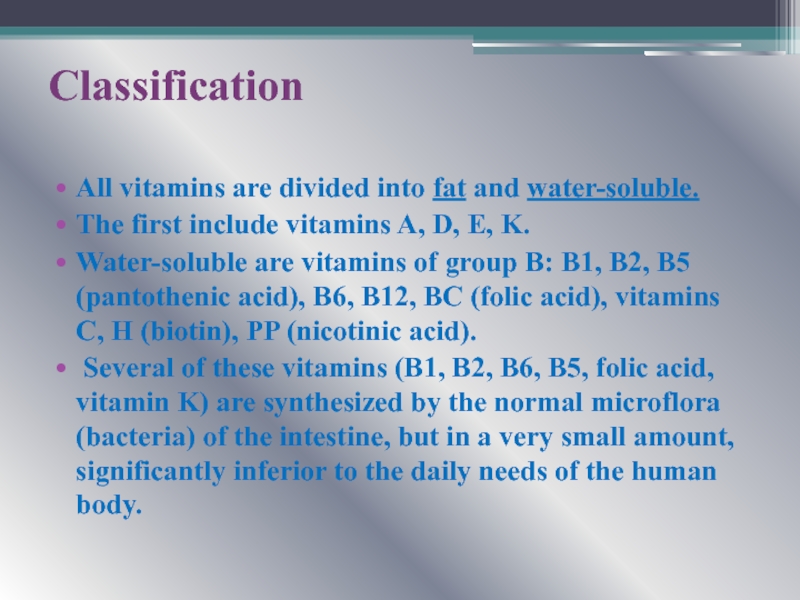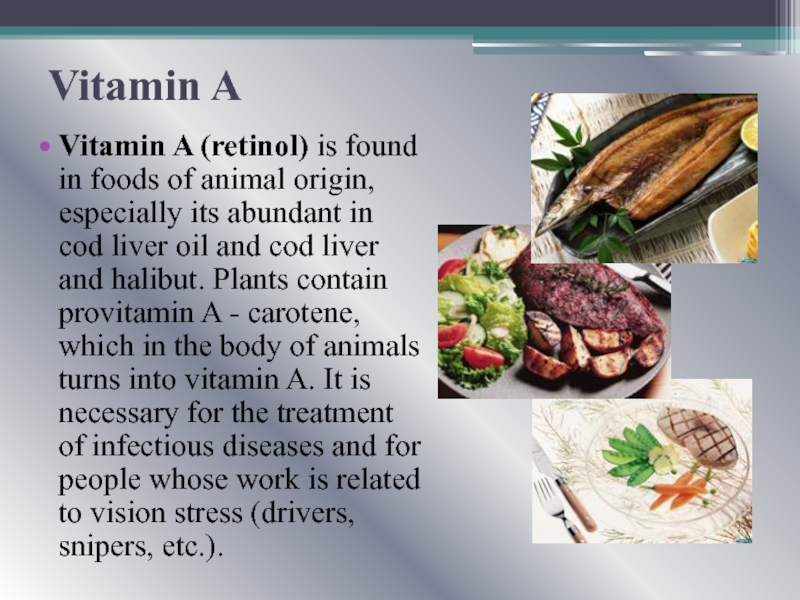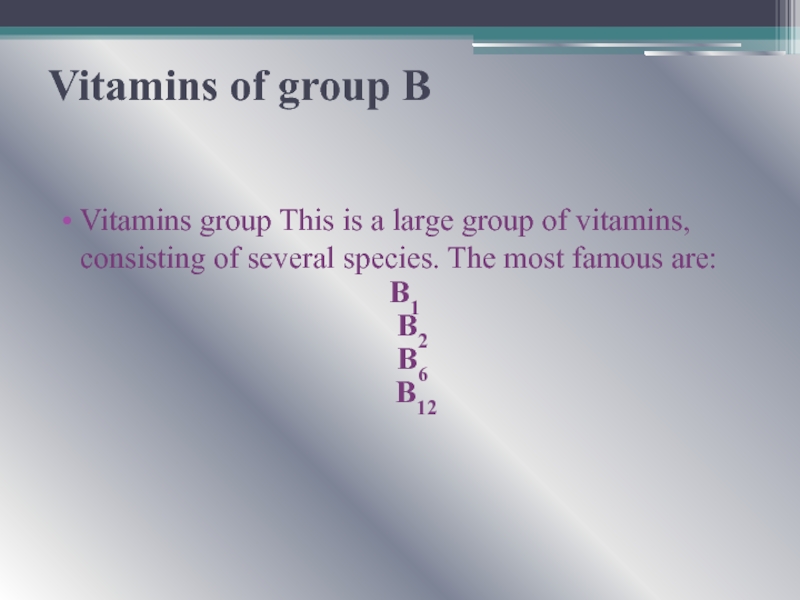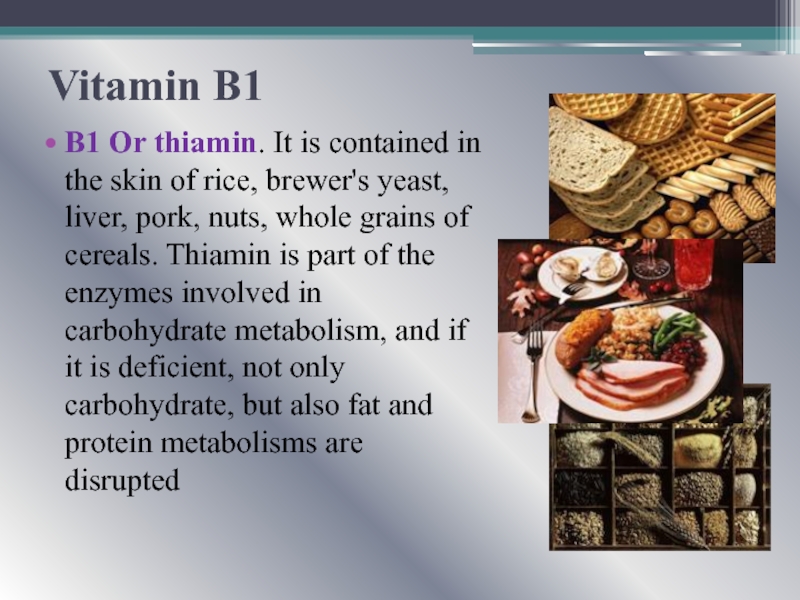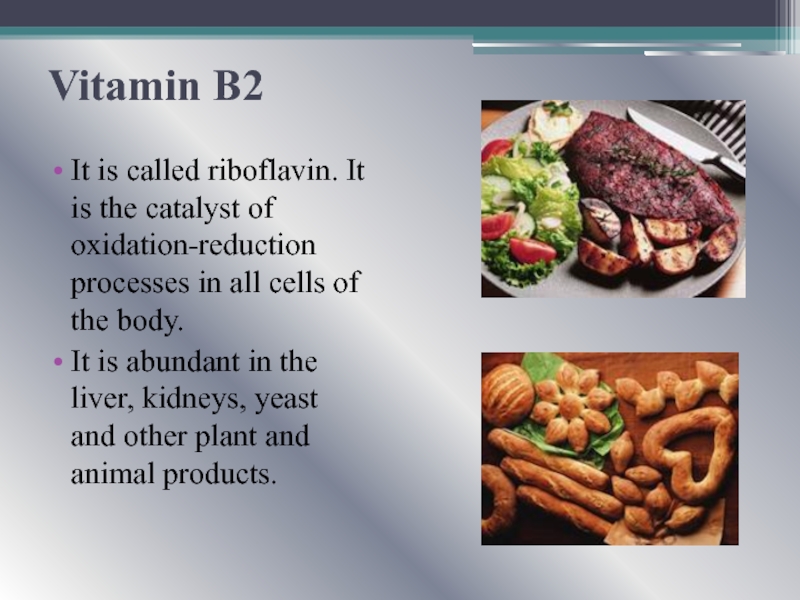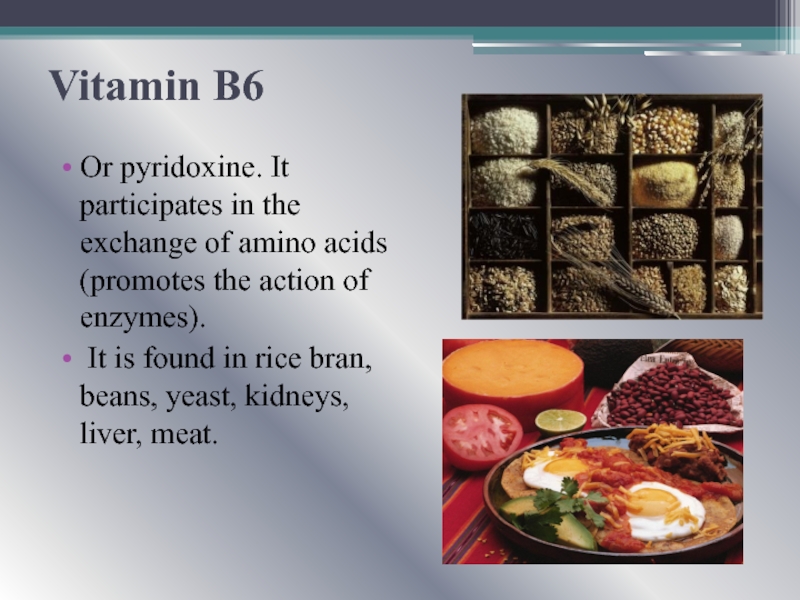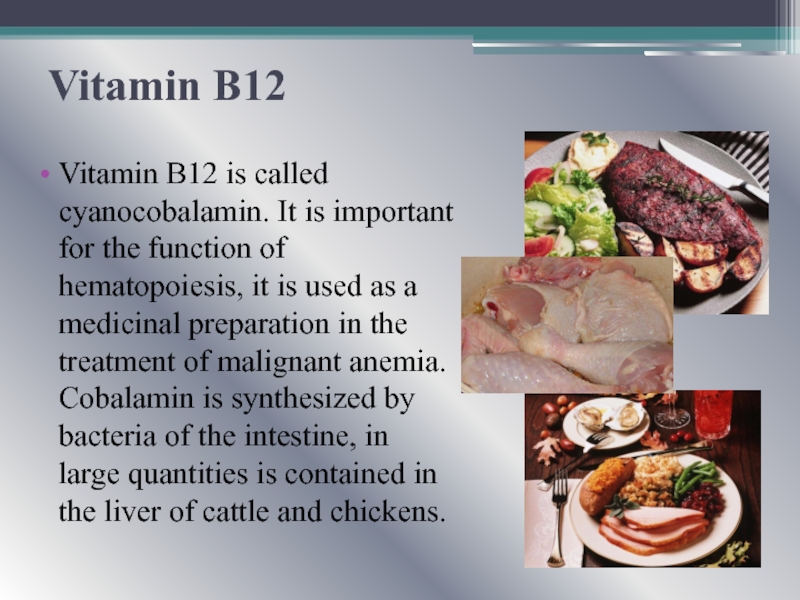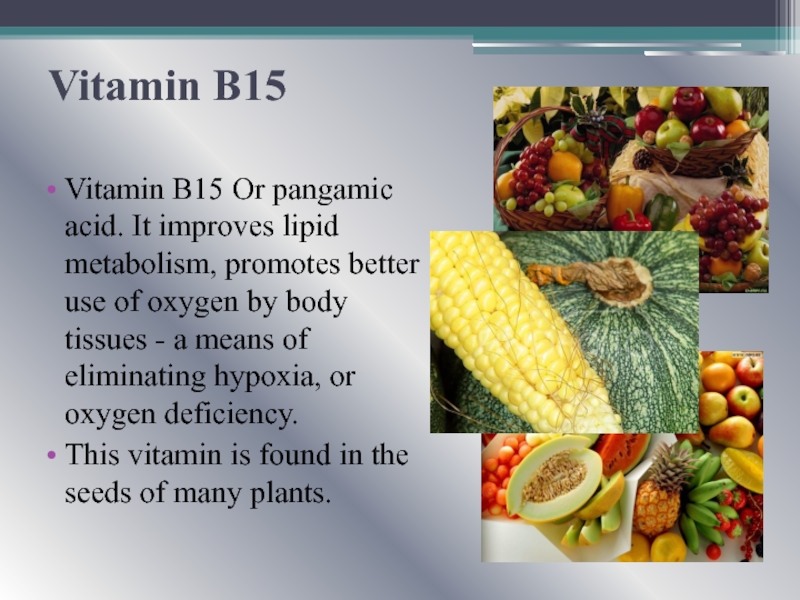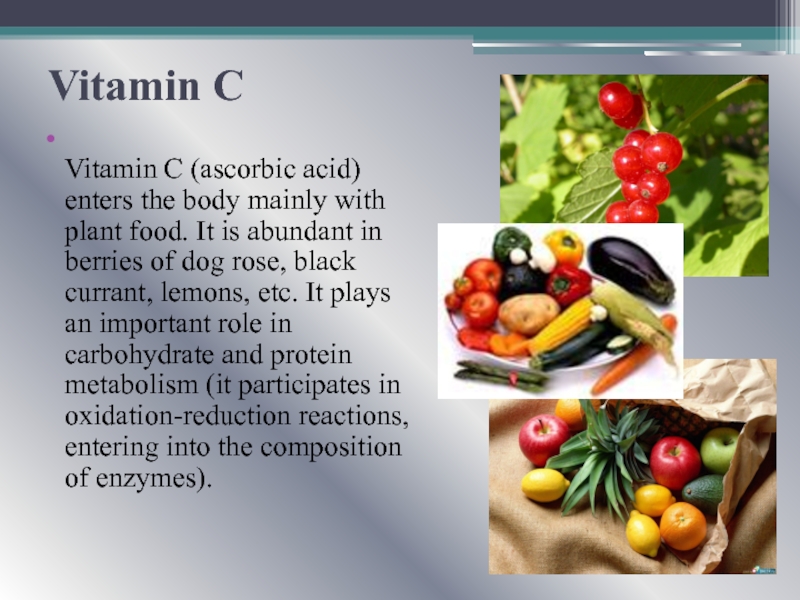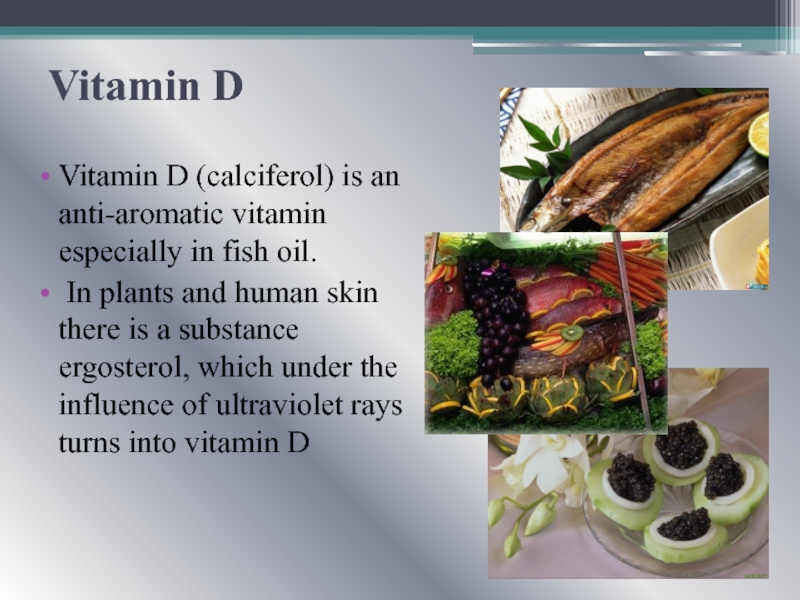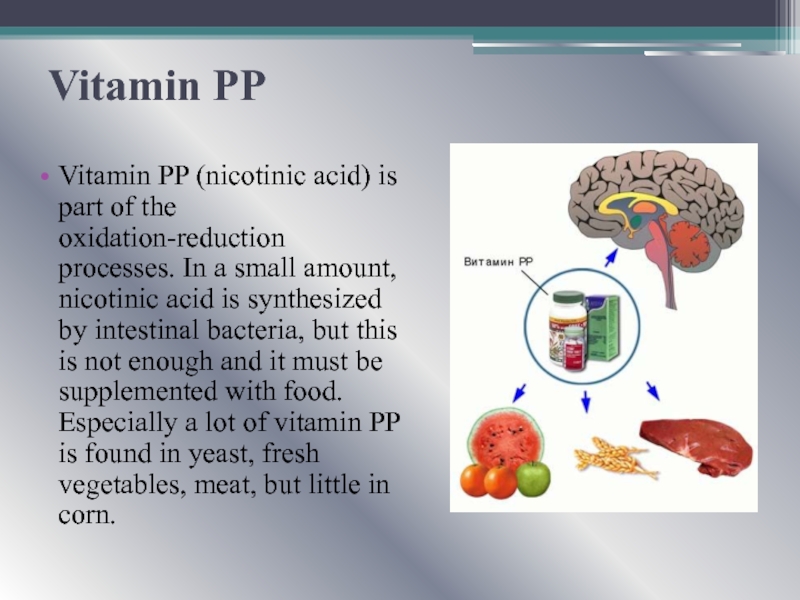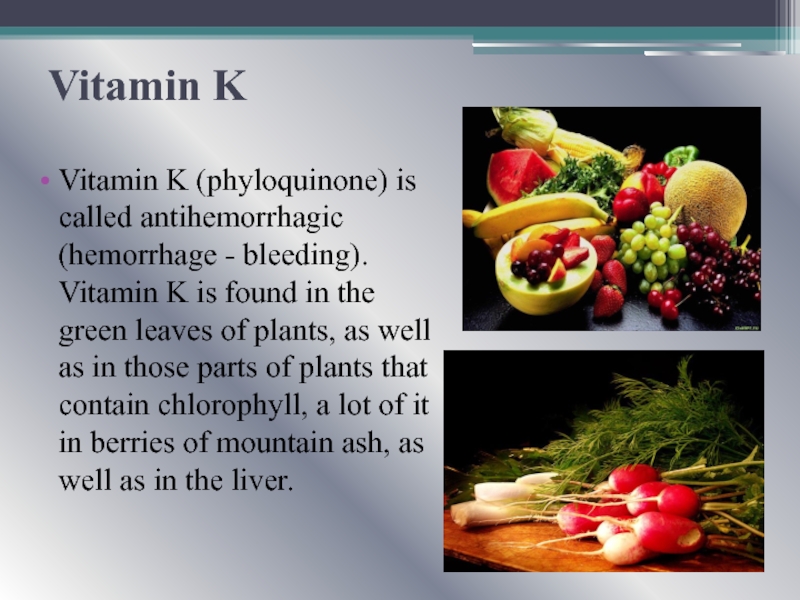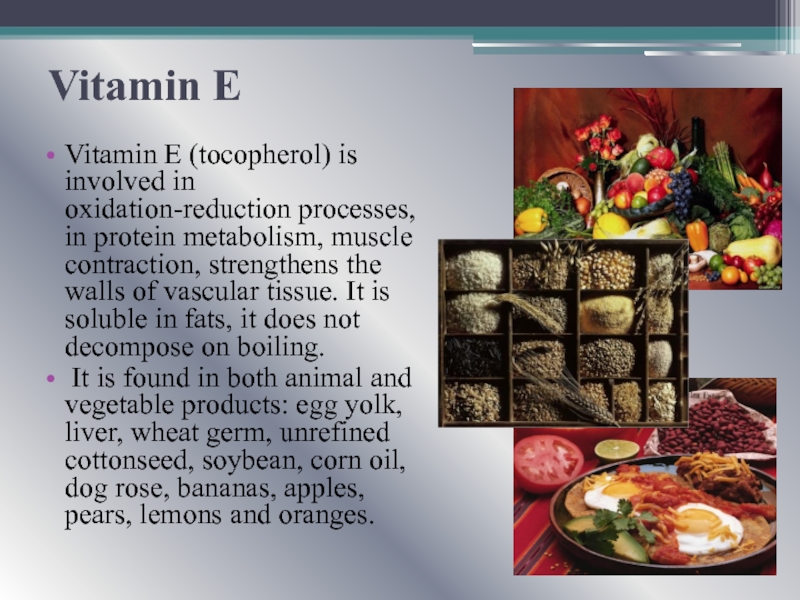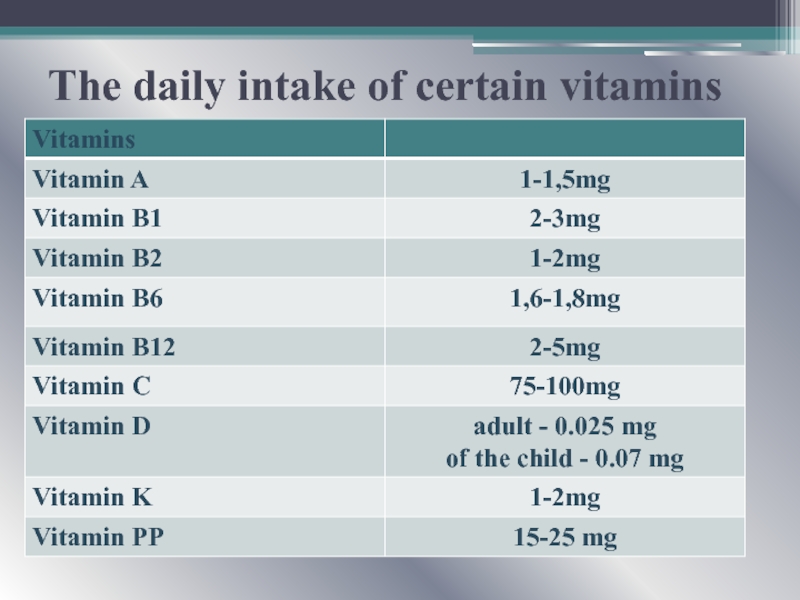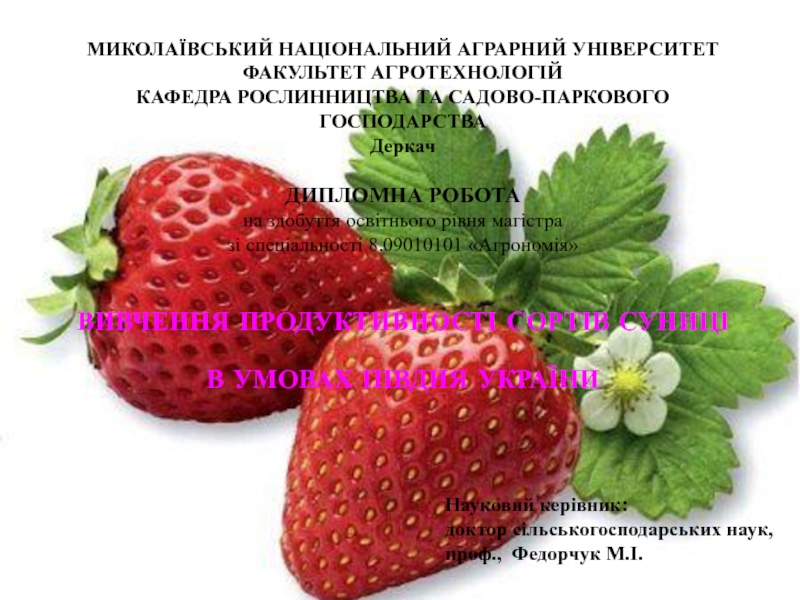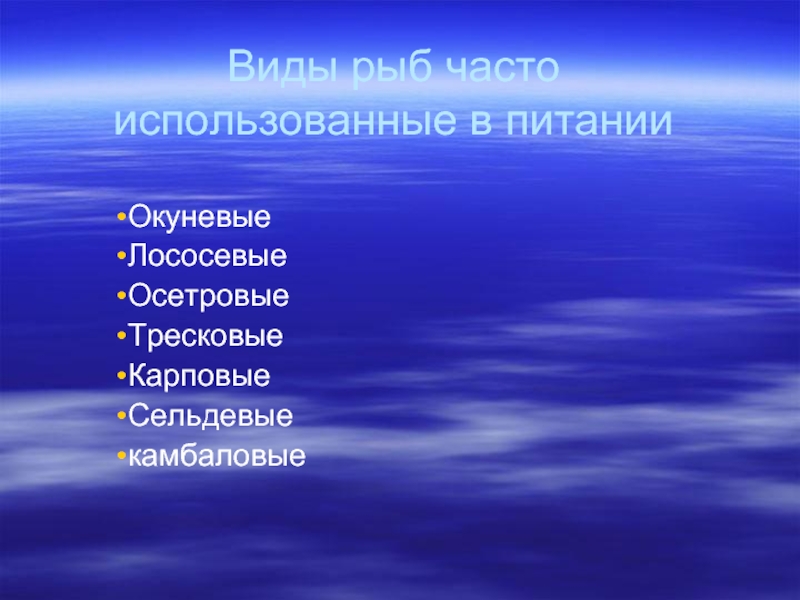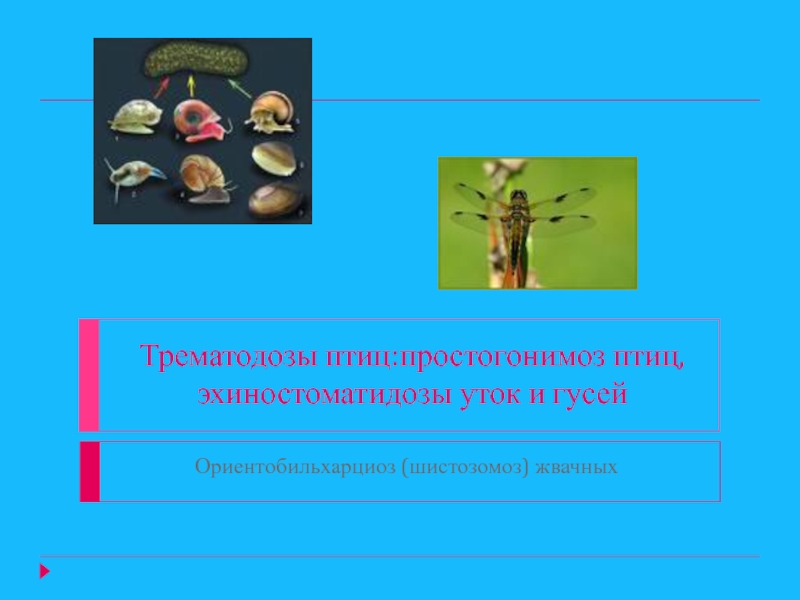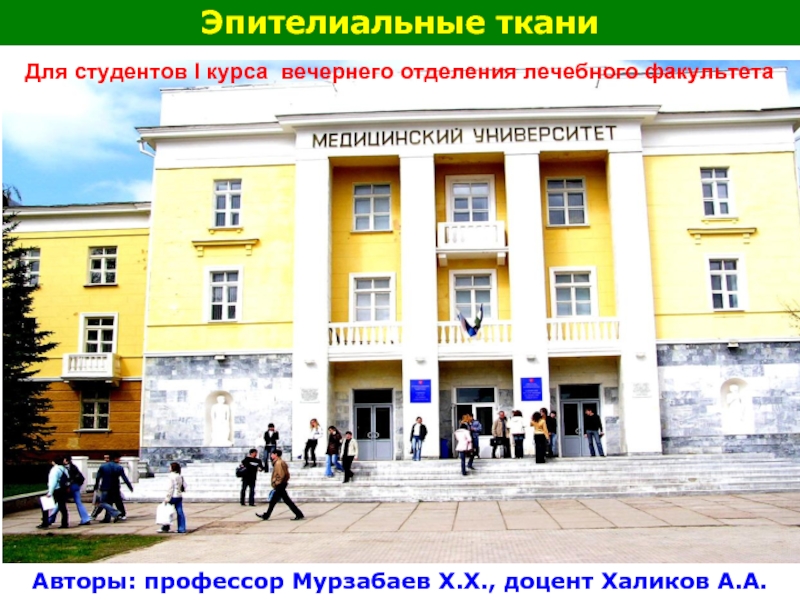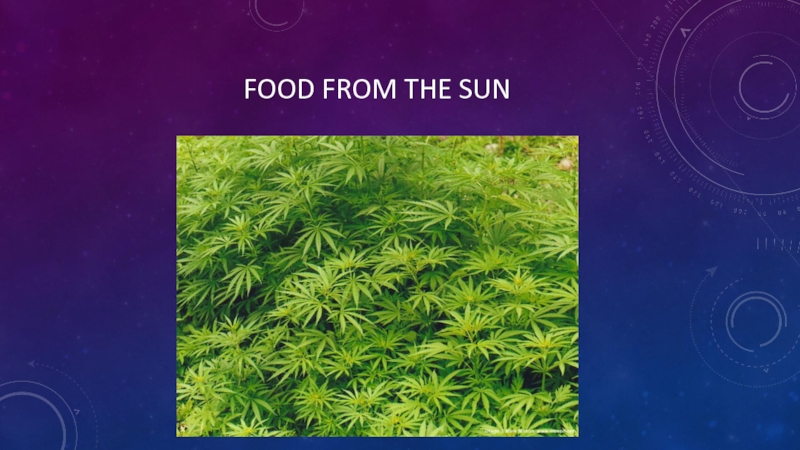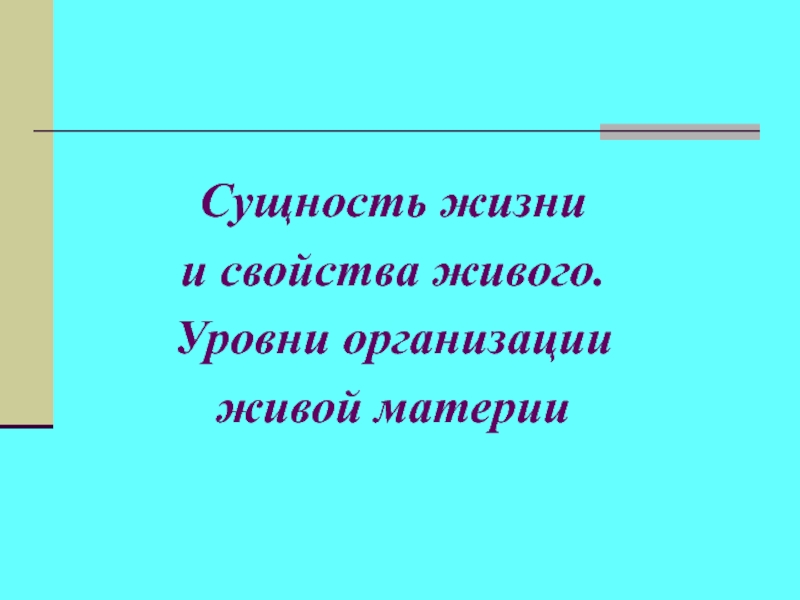- Главная
- Разное
- Дизайн
- Бизнес и предпринимательство
- Аналитика
- Образование
- Развлечения
- Красота и здоровье
- Финансы
- Государство
- Путешествия
- Спорт
- Недвижимость
- Армия
- Графика
- Культурология
- Еда и кулинария
- Лингвистика
- Английский язык
- Астрономия
- Алгебра
- Биология
- География
- Детские презентации
- Информатика
- История
- Литература
- Маркетинг
- Математика
- Медицина
- Менеджмент
- Музыка
- МХК
- Немецкий язык
- ОБЖ
- Обществознание
- Окружающий мир
- Педагогика
- Русский язык
- Технология
- Физика
- Философия
- Химия
- Шаблоны, картинки для презентаций
- Экология
- Экономика
- Юриспруденция
VITAMINS. History of the discovery of vitamins презентация
Содержание
- 1. VITAMINS. History of the discovery of vitamins
- 2. History of the discovery of vitamins
- 3. Vitamins Nutrients that our body does
- 4. Classification All vitamins are divided into fat
- 5. Vitamin A Vitamin A (retinol) is found
- 6. Vitamins of group B Vitamins group This
- 7. Vitamin B1 B1 Or thiamin. It is
- 8. Vitamin B2 It is called riboflavin. It
- 9. Vitamin B6 Or pyridoxine. It participates in
- 10. Vitamin B12 Vitamin B12 is called cyanocobalamin.
- 11. Vitamin B15 Vitamin B15 Or pangamic acid.
- 12. Vitamin C Vitamin C (ascorbic acid)
- 13. Vitamin D Vitamin D (calciferol) is an
- 14. Vitamin PP Vitamin PP (nicotinic acid) is
- 15. Vitamin K Vitamin K (phyloquinone) is called
- 16. Vitamin E Vitamin E (tocopherol) is involved
- 17. The daily intake of certain vitamins
Слайд 2History of the discovery of vitamins
In 1881 the Russian scientist N.I.
Lunin discovered that mice die if they are fed a food mixture consisting of purified foods. If you add 1 ml of milk to the diet, the mice remain healthy.
In the years 1911-1912. Polish scientist Kazimir Funk has isolated a preparation from bran and named it a vitamin. From this time, intensive study of vitamins began . Vitamins are denoted by the letters of the Latin alphabet A, B, C, D, E, F, P, etc. At present, most of the vitamins are isolated in pure form or synthesized and used as medicines.
In the years 1911-1912. Polish scientist Kazimir Funk has isolated a preparation from bran and named it a vitamin. From this time, intensive study of vitamins began . Vitamins are denoted by the letters of the Latin alphabet A, B, C, D, E, F, P, etc. At present, most of the vitamins are isolated in pure form or synthesized and used as medicines.
Слайд 3Vitamins
Nutrients that our body does not make on its own.
Thus we must obtain them from the foods we eat, or via vitamin supplements.
They are essential for providing good health and are necessary for many life functions.
They are regulator molecules. They regulate normal growth and development.
They are essential for providing good health and are necessary for many life functions.
They are regulator molecules. They regulate normal growth and development.
Слайд 4Classification
All vitamins are divided into fat and water-soluble.
The first include
vitamins A, D, E, K.
Water-soluble are vitamins of group B: B1, B2, B5 (pantothenic acid), B6, B12, BC (folic acid), vitamins C, H (biotin), PP (nicotinic acid).
Several of these vitamins (B1, B2, B6, B5, folic acid, vitamin K) are synthesized by the normal microflora (bacteria) of the intestine, but in a very small amount, significantly inferior to the daily needs of the human body.
Water-soluble are vitamins of group B: B1, B2, B5 (pantothenic acid), B6, B12, BC (folic acid), vitamins C, H (biotin), PP (nicotinic acid).
Several of these vitamins (B1, B2, B6, B5, folic acid, vitamin K) are synthesized by the normal microflora (bacteria) of the intestine, but in a very small amount, significantly inferior to the daily needs of the human body.
Слайд 5Vitamin A
Vitamin A (retinol) is found in foods of animal origin,
especially its abundant in cod liver oil and cod liver and halibut. Plants contain provitamin A - carotene, which in the body of animals turns into vitamin A. It is necessary for the treatment of infectious diseases and for people whose work is related to vision stress (drivers, snipers, etc.).
Слайд 6Vitamins of group B
Vitamins group This is a large group of
vitamins, consisting of several species. The most famous are:
В1
В2
В6
В12
В1
В2
В6
В12
Слайд 7Vitamin B1
B1 Or thiamin. It is contained in the skin of
rice, brewer's yeast, liver, pork, nuts, whole grains of cereals. Thiamin is part of the enzymes involved in carbohydrate metabolism, and if it is deficient, not only carbohydrate, but also fat and protein metabolisms are disrupted
Слайд 8Vitamin B2
It is called riboflavin. It is the catalyst of oxidation-reduction
processes in all cells of the body.
It is abundant in the liver, kidneys, yeast and other plant and animal products.
It is abundant in the liver, kidneys, yeast and other plant and animal products.
Слайд 9Vitamin B6
Or pyridoxine. It participates in the exchange of amino acids
(promotes the action of enzymes).
It is found in rice bran, beans, yeast, kidneys, liver, meat.
It is found in rice bran, beans, yeast, kidneys, liver, meat.
Слайд 10Vitamin B12
Vitamin B12 is called cyanocobalamin. It is important for the
function of hematopoiesis, it is used as a medicinal preparation in the treatment of malignant anemia. Cobalamin is synthesized by bacteria of the intestine, in large quantities is contained in the liver of cattle and chickens.
Слайд 11Vitamin B15
Vitamin B15 Or pangamic acid. It improves lipid metabolism, promotes
better use of oxygen by body tissues - a means of eliminating hypoxia, or oxygen deficiency.
This vitamin is found in the seeds of many plants.
This vitamin is found in the seeds of many plants.
Слайд 12Vitamin C
Vitamin C (ascorbic acid) enters the body mainly with plant
food. It is abundant in berries of dog rose, black currant, lemons, etc. It plays an important role in carbohydrate and protein metabolism (it participates in oxidation-reduction reactions, entering into the composition of enzymes).
Слайд 13Vitamin D
Vitamin D (calciferol) is an anti-aromatic vitamin especially in fish
oil.
In plants and human skin there is a substance ergosterol, which under the influence of ultraviolet rays turns into vitamin D
In plants and human skin there is a substance ergosterol, which under the influence of ultraviolet rays turns into vitamin D
Слайд 14Vitamin PP
Vitamin PP (nicotinic acid) is part of the oxidation-reduction processes.
In a small amount, nicotinic acid is synthesized by intestinal bacteria, but this is not enough and it must be supplemented with food. Especially a lot of vitamin PP is found in yeast, fresh vegetables, meat, but little in corn.
Слайд 15Vitamin K
Vitamin K (phyloquinone) is called antihemorrhagic (hemorrhage - bleeding). Vitamin
K is found in the green leaves of plants, as well as in those parts of plants that contain chlorophyll, a lot of it in berries of mountain ash, as well as in the liver.
Слайд 16Vitamin E
Vitamin E (tocopherol) is involved in oxidation-reduction processes, in protein
metabolism, muscle contraction, strengthens the walls of vascular tissue. It is soluble in fats, it does not decompose on boiling.
It is found in both animal and vegetable products: egg yolk, liver, wheat germ, unrefined cottonseed, soybean, corn oil, dog rose, bananas, apples, pears, lemons and oranges.
It is found in both animal and vegetable products: egg yolk, liver, wheat germ, unrefined cottonseed, soybean, corn oil, dog rose, bananas, apples, pears, lemons and oranges.
